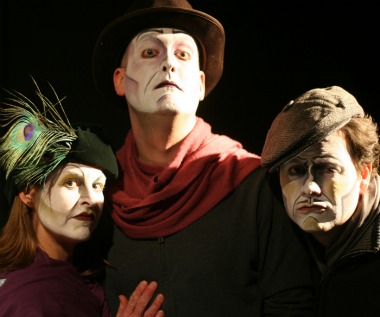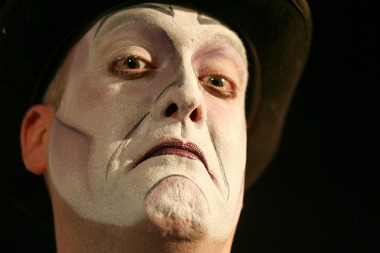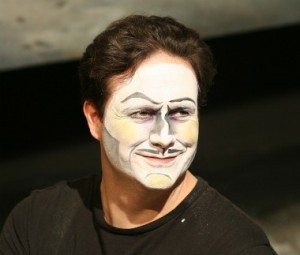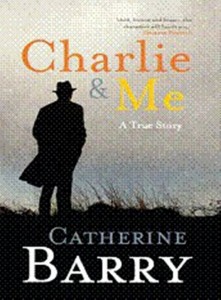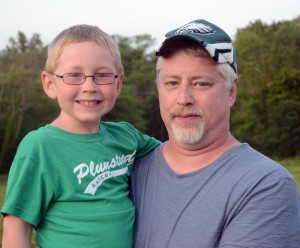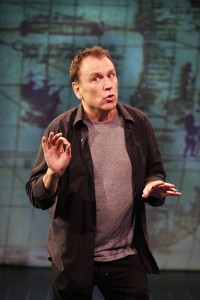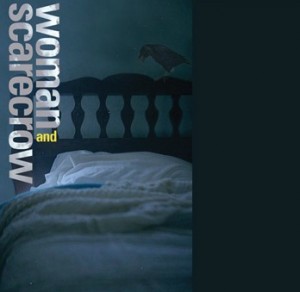 A woman lies on her deathbed, time ticking away, the end imminent. As she comes face to face with her mortality, she nurses regrets, mourns missed opportunities and contemplates the nature of her complicated marriage to a unfaithful husband. She is accompanied on her final journey by a friend, unseen to others, who is both comforter and critic.
A woman lies on her deathbed, time ticking away, the end imminent. As she comes face to face with her mortality, she nurses regrets, mourns missed opportunities and contemplates the nature of her complicated marriage to a unfaithful husband. She is accompanied on her final journey by a friend, unseen to others, who is both comforter and critic.
Like most quick summaries of a complex piece of art, this bit of shorthand doesn’t do justice to Irish playwright Marina Carr’s ultimately redemptive “Woman and Scarecrow,” on tap for Villanova University’s Vasey Theatre November 8 through 20. “Woman and Scarecrow” has been described by reviewers as “spirited,” “biting,” “poetic” and “fierce and funny.”
(Hey, it’s Irish. It’s about death. Of course there are laughs.)
The play is not the first visible evidence of a unique new educational exchange program between Villanova’s well-known Irish Studies department and the Abbey Theatre, the national theatre of Ireland, but it might boast the highest profile. Described as “an historic intellectual/artistic partnership,” the new exchange program will expose Villanova students and outside audiences to renowned Irish actors, directors and writers; at the same time, Villanova students will travel to Dublin to study and work with the Abbey Theatre.
Directing “Woman and Scarecrow” is actor-friar Father David Cregan, O.S.A., associate professor and chair of the theatre department.
We talked to him about the play and the new relationship with the Abbey Theatre.
Question: Tell me about this play. What is it about to you and why do you like it?
Answer: “Woman and Scarecrow” has all the best qualities of an Irish play. It has a powerful story, it’s written with a kind of poetic prose that is indicative of the Irish dramatic tradition, and it also balances the comic and the tragic elements of the human existence in quite an epic way. That makes it a shining example of Irish theatre. The ability to both laugh and cry and to celebrate and mourn simultaneously—that’s part of the Irish aesthetic in general.
The play was attractive to me because of the epic way in which it deals with the really important questions of life and death. It allows the audience to enjoy a powerful story that simultaneously has a prophetic message about how to live life to its fullest, how to value oneself and how to live in the right relationship with the world. It tells the story through a series of tragedies and triumphs, through a series of failures and accomplishments in the life of Woman. But the play also has a sort of transnational quality in the way that it speaks to the human condition. It’s not only the Irish condition. It allows us to witness the last moments of this woman’s life as she tries to reconcile herself with her choices and deals with the repercussions of her mistakes.
Question: You’re an actor-director, but you’re also a priest. How do you look upon this play from the priest’s perspective?
Answer: It confirms something that both religion and theater share in common. If you’re familiar with the Roman Catholic creed, the line in the creed that really calls out to me is this one: “We believe in the seen and the unseen.” This play, while it tells a very specific story, has a kind of global outreach in the sense that it articulates both the seen and unseen qualities of what it means to be a human being, and it really connects the spiritual and the material in the way that it builds the relationship between Woman and the Scarecrow. The question in the play is, who or what is Scarecrow? Scarecrow appears on the stage for the entire production, and is physically and metaphysically connected with Woman, but she’s another element of her. The other characters in the play, when they come into the room, don’t see or acknowledge that Scarecrow is there. It’s kind of an embodiment of the spiritual component of the human condition. Scarecrow is not just her conscience, not editing or condemning her for a licentious lifestyle, but is pointing out to her that the mistake she made was in not valuing her life in the way that she should have; that her mistakes were that she didn’t treat herself well. [In this way, Scarecrow] helps woman cross from the world of the living into death. Those are the kinds of things they talk about the whole play. The play has an acknowledgement of the ethereal—or as I would describe it, of the spiritual—that definitely connects with my larger worldview of spiritual responsibility.
Question: Did Villanova’s theatre department choose this play, or was it a more collaborative decision with Abbey Theatre? And what role did the Irish Studies department play?
Answer: When the relationship with the Abbey Theatre began to materialize, we started to think of ways of making a connection. “Woman and Scarecrow” was a natural fit for me because my research and my writing is all in the area of contemporary Irish drama. I was interested in the potential and the power of the play. So many of the themes in the play are important Irish themes about returning home, and in particular returning to the West of Ireland and its curative and humane qualities. They speak of homecoming. Homecoming is not just about the connection to place or earth; it’s also a kind of spiritual reckoning.
Question: Marina Carr was a Heimbold professor at Villanova in 2003. Did that have anything to do with the choice of this play?
Answer: We’ve been connected with her work; we’ve produced it before. She was a friend of the department. This particular piece of work in my opinion is a triumph in her writing, a high point in her career, even though it’s a relatively small play.
Question: You’re an Irish fella. What’s appealing to you about doing Irish Theatre.
Answer: What I love about the Irish theatre is its courage, the exploration of deep emotion, and its interest in the journey of the soul and of the mind. This play contains all of that. It’s an actor’s dream come true because of the breadth of its emotional expression, and it’s a director’s dream come true because the script is so beautifully and poetically written. It really exhibits a kind of emotional complexity that is part of Irish artistic expression, a kind of courage to look at the harder, darker things. That’s one of the things I love about Irish plays—it’s the deep feeling at the center of it all.
- irishphiladelphia.com readers get a 50 percent discount on tickets. Click on the Direct Ticketing Link or call the ticket office at 610-519-7474 and use the code IRISHPHILLY.

